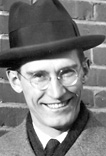 As Harley-Davidson’s first export representative to Africa in 1922, Alfred Rich Child was used to breaking new ground. His career at Harley-Davidson also included serving as Managing Director of Sales in pre-World War II Japan, as well as negotiating the contract that would give Sankyo Company exclusive rights to manufacture Harley-Davidson products in that country. Following the war, Child founded the Rich Child Cycle Co., a distributor of BSA and Sunbeam motorcycles.
As Harley-Davidson’s first export representative to Africa in 1922, Alfred Rich Child was used to breaking new ground. His career at Harley-Davidson also included serving as Managing Director of Sales in pre-World War II Japan, as well as negotiating the contract that would give Sankyo Company exclusive rights to manufacture Harley-Davidson products in that country. Following the war, Child founded the Rich Child Cycle Co., a distributor of BSA and Sunbeam motorcycles.
Born in Chichester, Sussex, England in 1891, Child was the son of a retired British Navy officer. He graduated from the Greenwich Royal Naval Academy in 1907.
Making his way to the United States by working as a steward for the Cunard line, Child worked various odd jobs, eventually starting his own traveling clothing supply business serving the grand estates on Long Island. His choice of delivery vehicle was a 1914 Harley-Davidson sidecar outfit.
After the start of World War I, Child joined the U.S. Coast Guard and served as a petty officer. While serving at the passport office in New York City, he met David Weistrich, who owned a wholesale bicycle parts business. In 1918, Child joined Weistrich’s business as a traveling representative to the southern states. Once again, Child’s transportation choice was a J Model Harley-Davidson with sidecar.
When Weistrich became ill and relinquished control of the business to his brother-in-law, Child began looking for new sales opportunities and applied with the Harley-Davidson Motor Company. He soon received a telegram from sales manager Arthur Davidson, and the two met in New York. After some discussion, Childs was hired and assigned to domestic sales for the northeast United States and eastern Canada, followed by sales positions in the southern states and eventually in Harley-Davidson’s hometown of Milwaukee in 1921.
Upon returning from a tour of Europe and South Africa on Harley’s behalf, Child was informed that he should prepare himself for a survey of the Far East markets. Child arrived in Yokohama, Japan in July of 1924.
The Asian markets represented a challenge to Harley-Davidson. Not only was the Indian brand firmly entrenched there and importing 600-700 units a year, but the existing Harley-Davidson distributors were not ordering spare parts and were competing with each other in conflict of their contracted distribution territories. After lengthy attempts to resolve the problems, Child chose to sever ties with the existing distributors, but did maintain relations with one successful dealer.
The Koto Trading Company was a division of Sankyo, a large pharmaceutical manufacturer based in Tokyo. Unbeknownst to their management, Koto had been the recipient of “bootleg” shipments of Harley-Davidsons that were supposed to be sold in Mongolia - but were instead diverted to Koto in Japan - in conflict with Harley-Davison’s distribution agreements. However, Koto had been very successful and had sold all the inventory originally intended for Mongolia.
In August 1924, Child returned to Japan with an agreement with Harley Davidson and the Koto Trading Company to establish the Harley-Davidson Motorcycle Sales Company of Japan, with Child acting as managing director. The company set up shop at Kyobashi Crossing in Tokyo with a supply of 350 motorcycles and $25,000 in spare parts. Within the next two years, Harley-Davidson sales in Japan eclipsed those of Indian and the Harley-Davidson Motorcycle Sales Company of Japan was doing a brisk business in replacement parts.
While other brands of motorcycles were being imported for the Japanese market, only the Harley-Davidson was built as a commercial carrier and could be used to carry everything from candy to cement. Childs and his staff exploited this fact to great success. The well-connected Sankyo firm also convinced military and other government institutions to adopt the Harley-Davidson.
A fluctuating yen led Child to the idea of manufacturing Harley-Davidsons in Japan. With backing from the Sankyo company, in 1929 the Harley-Davidson Motorcycle Sales Company of Japan established the Shinagawa factory, the first motorcycle production factory in Japan.
In spite of the success of the Harley-Davidson Motorcycle Sales Company of Japan, changing business relationships forced Child to leave the company in 1936. He immediately started Nichiman Harley-Davidson Sales in Tokyo, importing Harley-Davidsons from Milwaukee, and ran that operation until 1937, when a nearly eight-fold import tariff increase combined with national political tensions made it impossible to continue business.
Child returned to the United States and in 1945 obtained the national distributorship rights for BSA and Sunbeam motorcycles by the Rich Child Cycle Co., Inc., which was sold to BSA Motorcycles Ltd. England in 1954.
In 1977 Child wrote: “It is fair to state that (Shinagawa factory superintendent) Fred Barr, Harley-Davison Co. and Sankyo Co. Ltd. are the fathers of the Japanese Motorcycle Industry, which in recent years has swept the world with its remarkably clever and efficient models.”
He was inducted into the AMA Motorcycle Hall of Fame in 2006.